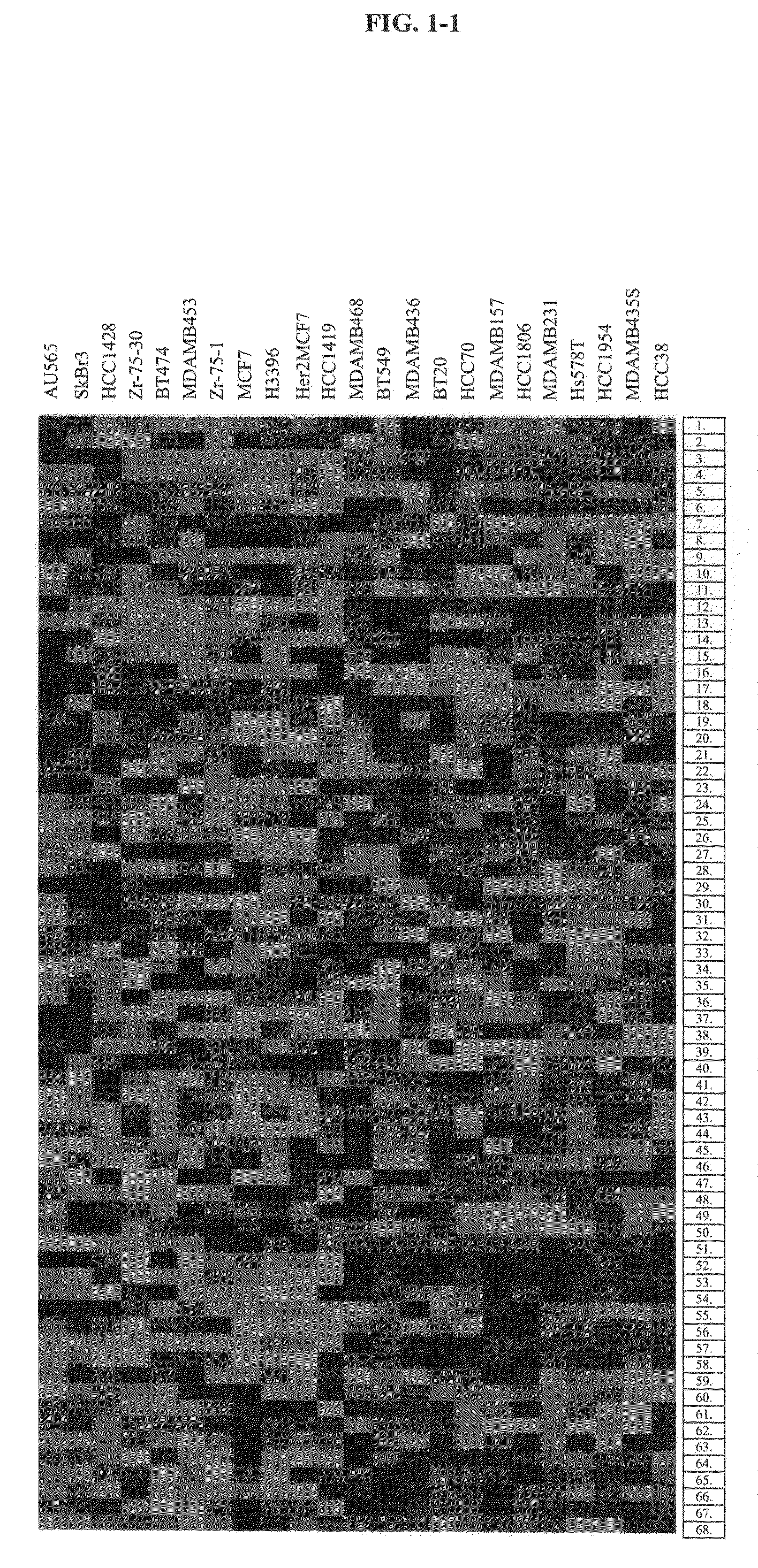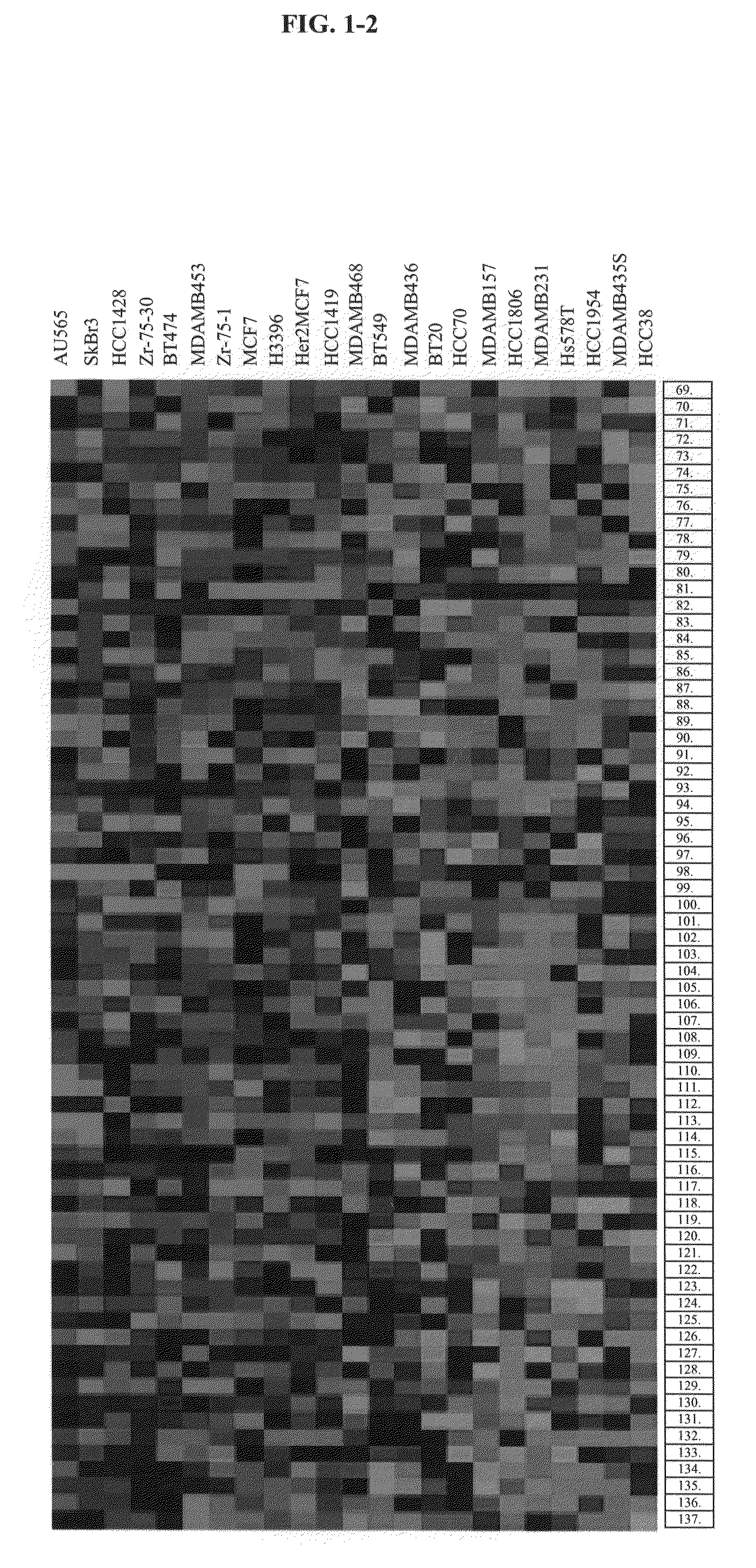Methods of using EPHA2 for predicting activity of compounds that interact with and/or modulate protein tyrosine kinases and/or protein tyrosine kinase pathways in breast cells
a technology of protein tyrosine kinase and epha2, applied in the field of pharmacogenomics, can solve the problem of difficult to predict drug sensitivity in patients, and achieve the effect of improving drug sensitivity
- Summary
- Abstract
- Description
- Claims
- Application Information
AI Technical Summary
Benefits of technology
Problems solved by technology
Method used
Image
Examples
example 1
Methods
IC50 Determination—In Vitro Cytotoxicity Assay
[0258]The protein tyrosine kinase inhibitor compound (described in international application WO 00 / 62778, published Oct. 26, 2000) was tested for cytotoxicity in vitro against a panel of twenty-three human breast cell lines available from the American Type Culture Collection, ATCC, except H3396, which was obtained from Pacific Northwest Research Institute, Seattle Wash. The MCF7 / Her2 cell line was established by stable transfection of MCF7 cells with the HER2 gene. Cytotoxicity was assessed in cells by the MTS (3-(4,5-dimethylthiazol-2-yl)-5-(3-carboxy-methoxyphenyl)-2-(4-sulphenyl)-2H-tetrazolium, inner salt) assay (T. L. Riss et al., 1992, Mol. Biol. Cell, 3 (Suppl.):184a).
[0259]To carry out the assays, the breast cells were plated at 4,000 cells / well in 96 well microtiter plates, and 24 hours later, serially diluted drugs were added. The concentration range for the protein tyrosine kinase inhibitor compound BMS-A used in the cy...
example 2
PCR Expression Profiling
[0274]RNA quantification is performed using the Taqman® real-time-PCR fluorogenic assay. The Taqman® assay is one of the most precise methods for assaying the concentration of nucleic acid templates.
[0275]RNA is prepared using standard methods, preferably, employing the RNeasy Maxi Kit commercially available from Qiagen (Valencia, Calif.). A cDNA template for real-time PCR can be generated using the Superscript™ First Strand Synthesis system for RT-PCR. Representative forward and reverse RT-PCT primers for each of the protein tyrosine kinase biomarker polynucleotides of the present invention are provided in Table 6.
[0276]SYBR Green real-time PCR reactions are prepared as follows: The reaction mix contains 20 ng first strand cDNA; 50 nM Forward Primer; 50 nM Reverse Primer; 0.75×SYBR Green I (Sigma); 1×SYBR Green PCR Buffer (50 mM Tris-HCl pH 8.3, 75 mM KCl); 10% DMSO; 3 mM MgCl2; 300 μM each dATP, dGTP, dTTP, dCTP; 1 U Platinum® Taq DNA Polymerase High Fideli...
example 3
Production of an Antibody Directed Against Protein Tyrosine Kinase Biomarker Polypeptides
[0281]Anti-protein tyrosine kinase biomarker polypeptide antibodies of the present invention can be prepared by a variety of methods as detailed hereinabove. As one example of an antibody-production method, cells expressing a polypeptide of the present invention are administered to an animal as immunogen to induce the production of sera containing polyclonal antibodies directed against the expressed polypeptide. In a preferred method, the expressed polypeptide is prepared, preferably isolated and / or purified, to render it substantially free of natural contaminants using techniques commonly practiced in the art. Such a preparation is then introduced into an animal in order to produce polyclonal antisera of greater specific activity for the expressed and isolated polypeptide.
[0282]In a most preferred method, the antibodies of the present invention are monoclonal antibodies (or protein binding frag...
PUM
| Property | Measurement | Unit |
|---|---|---|
| Volume | aaaaa | aaaaa |
| Volume | aaaaa | aaaaa |
| Volume | aaaaa | aaaaa |
Abstract
Description
Claims
Application Information
 Login to View More
Login to View More - R&D
- Intellectual Property
- Life Sciences
- Materials
- Tech Scout
- Unparalleled Data Quality
- Higher Quality Content
- 60% Fewer Hallucinations
Browse by: Latest US Patents, China's latest patents, Technical Efficacy Thesaurus, Application Domain, Technology Topic, Popular Technical Reports.
© 2025 PatSnap. All rights reserved.Legal|Privacy policy|Modern Slavery Act Transparency Statement|Sitemap|About US| Contact US: help@patsnap.com



